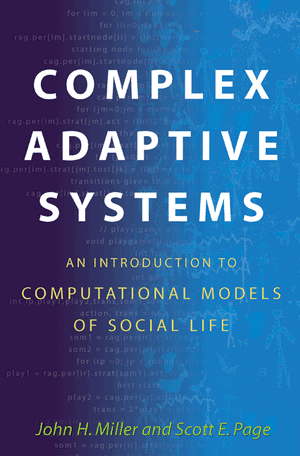Here is a list of the agent-based models described in Complex Adaptive Systems using NetLogo, these systems becoming interactive and fun! After installing NetLogo, click on one of the models below to view the systems.
- Although standing ovations seem to arise spontaneously, this simple model examines mathematically how a standing ovation can spread throughout a crowd.
- You can adjust the performance quality, seat location, group size, and more to see the influence they have on provoking a standing ovation.
Beehive Temperature (pg. 14-15)
- Bees must maintain their hive temperature within a fairly small threshold. They do so by huddling together to increase the temperature, or spreading out to decrease it. This model explains how a group of bees with a diverse set of temperature sensitivities maintain a more stable environment than a group of more similar bees would.
- You can adjust the number of bees, hive insulation, cooling and heating power to see the bees adjust the hive temperature.
- Bees attack when threatened. To announce the presence of a threat, a bee will release chemical pheromones that recruit other bees in the hive. Each bee, however, has a particular threshold, or the amount of pheromones that must be produced to illicit a response.
- This model illustrates how a hive with a diverse set of thresholds may be activated to respond to a threat more easily than one in which all the bees exhibit similar thresholds.
- Preferences and mobility are the name of the game for this model. The model assumes two towns, each with three citizens, and the towns are facing a difficult choice over an important public good: whether to serve green or red chili at their annual picnic. It illustrates how, given majority rule and mobility, citizens with different preferences can all enjoy their favorite chili.
- You can adjust the number of cities and citizens in this clear introduction to Tiebout’s concept of “voting with your feet.”
- If a system is subject to interactions with outside influences, the feedback my have an effect on the system. Negative feedback is quickly absorbed and the system reaches stability. When exposed to positive feedback, however, changes are amplified and lead to instability.
- This model explains how microlevel rules, can lead to global patterns in both space and time.
Forest Fires (pg. 102-110, 176)
- In this model, trees grow in the forest, but during the lightning season, some trees get struck down. When trees get hit, forest fires start and burn down neighboring trees. This simple model can provide some provocative results with respect to productivity and growth.
- You can adjust the forest layout, tree density, growth rate, and fire rate to see the trees go from individual entities to an interconnected unit.
Cellular Automota (pg. 111, 115-124)
- In this model, two-state agents (0 or 1) are arranged around in a circle. At each time interval, agents examine their own state and their neighbors’ states, and then determine their next state. Different perspectives of this model will yield unique interpretations of what is actually taking place.
- You can adjust the preferences of the agents and watch how the various inputs yield a variety of results.
Schelling’s Segretation Model (pg. 143-146, 163-164)
- This is a classic model of racial segregation. Each agent has a certain preference for leaving near those of the same type and a threshold for diversity until they will move. When the number of same-type neighbors falls short of this threshold, the agent will randomly relocate to a new spot.
- Remarkably, despite some tolerance for variety, this model shows that segregation is still likely to occur due to the tipping phenomenon.
- City formation depends on both space and residential agglomeration. A city’s spacial location influences many of its resources, while agglomeration results in both positive and negative externalities. Agents evaluate their surroundings based on population size and the average distance of the agent to all other agents. Randomly, an agent will update his information and move to a location that suits his preferences. Cities form as the result of minor changes, a few agents moving away from other agents, have great effects.
Majority Rule (pg. 124-129, 156, 158-163)
- In this model, every agent wants to be part of the majority. Different updating rules, such as asynchronous locations or incentives, will lead to different equilibrium outcomes.
- As sand accumulates on a table, piles form and reach a maximum angle of repose. At this point, the pile is considered critical, and any additional sand grains will cause the pile to fall. Adjust the location of the sand piles, and watch them fall like dominoes or as waves.
- This simple class is the foundation for game theory. Two agents each have to make a decision between two possible actions, without knowing what the other agent will pick. Once the agents have decided, however, the payoffs are determined based on the joint actions of both players.
Prisoner’s Dilemma with Communication (pg. 194)
- This model developed from the 2 x 2 games, but now agents are allowed to communicate. Once this situation arises, the system is loaded with communication and mutual cooperation.



